
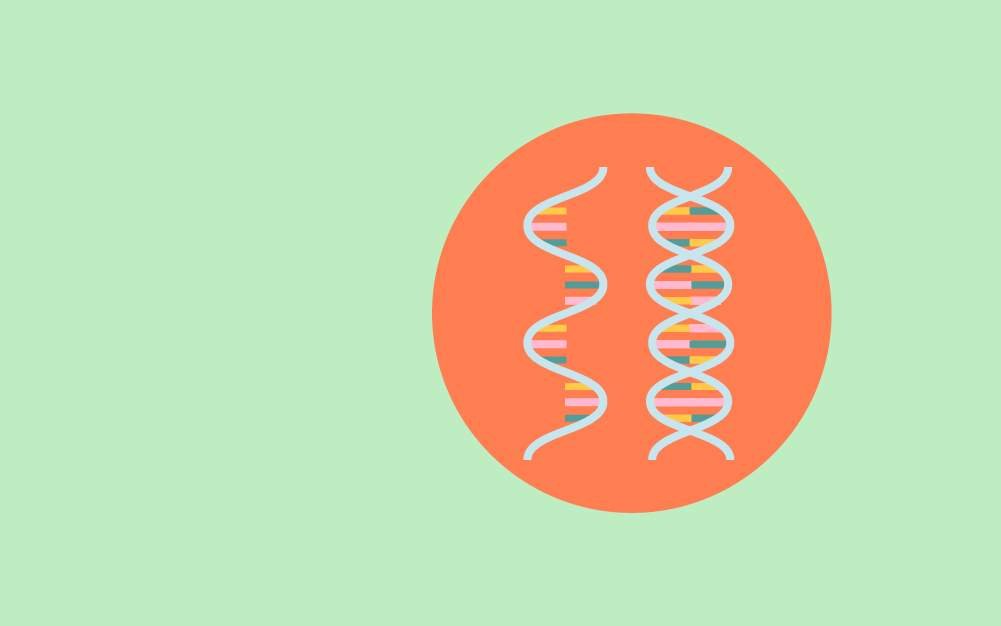
Cytogenetics was introduced in 1900 as a tool to determine the correct number of chromosomes of an organism. Since the 1970s, it has been used to detect clinical syndromes; it helped to understand the chromosomal aberrations and phenotypes associated with it.
Karyotyping was the first cytogenetics tool used to study the characteristics of chromosomes. But, the resolution of this method was not enough to study the precise position and function of a gene in a chromosome. The limitations[7] of karyotyping were: (1) it could only analyze >3 MB of DNA, (2) the process required mitotically active cells, (3) it was difficult to study the complex chromosomal rearrangements, and (4) preparation of slides were required (which made it a time taking process).
Later in the 1980s, molecular cytogenetic techniques were introduced, which brought a different era of analyzing chromosomes with variant colors. This was the first technique to introduce the concept of “in situ hybridization”. It helped the researchers in different ways[7]: (1) by boosting the chromosome mapping strategies, (2) permitted the identification of complex chromosome rearrangements, and (3) helped in the identification of chromosomal aberrations such as translocation, deletion, insertion, and inversion.
Pinkel introduced the Fluorescent in situ hybridization technique in 1986; he used fluorescently labeled probes to analyze the genomic DNA/RNA region for any abnormalities. The labeled probes bind and glow to their complementary regions on the chromosome – this can be observed using a fluorescent microscope. Molecular cytogenetics has paved the way for clinical and research developments by introducing the FISH technique to diagnose and treat abnormalities.
This method is highly efficient over the classic Karyotype technique, as it requires less time (it does not require cell culture) and provides a high-resolution view of the chromosomes. This technique allowed scientists to have a closer look at chromosomal aberrations and to diagnose the abnormalities with more accuracy and precision[7].
Method
DNA probes and target sequences are the two basic elements of FISH.
Probes
The choice of probes depends on the chromosomal regions to analyze. The three main types[7] of probes include:
Mechanism
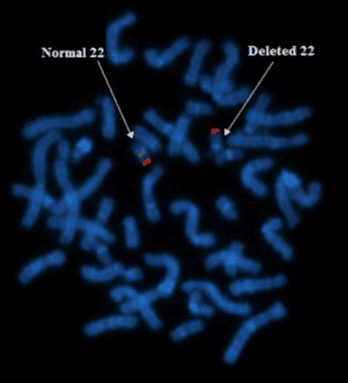
Figure: The image shows the deletion of chromosome 22 by using the FISH technique. Notice the absence of green color in the chromosome pointed by the arrow on the right-hand side.
Advantages
Limitations
The use of probes (in the FISH techniques) to analyze the chromosomes, requires the pre-knowledge of chromosomal aberration, which makes the analysis a complex process. To overcome this limitation, the FISH technique was modified several times for different diagnostic and research purposes based on the type of specimen to be analyzed or the information needed. Thus, genome-wide screening techniques were introduced, which produced precise and more reliable results compared to the previous techniques. These techniques involve:
The following sections will give a brief description of the modified FISH techniques with their limitations and advantages.
CGH technique helps in the detection of copy number variation in the chromosome of an organism without the need for cultured cells. This technique (in comparison to FISH) is less time-consuming and provides an overview of specific chromosomal regions that have undergone deletion or duplication (which causes pathogenesis). It is more efficient in the analysis of oncogenes/cancer.
Method
CGH involves the labeling of DNA of interest and control samples with two different fluorescent probes. Like, label the test sample (tumor DNA) with green color and the control (normal sample) in the red color. Then, hybridize the metaphase chromosomes with both probes on the slide. The computer algorithm then gives the ratio of fluorophore generated by photometric analysis of the two DNA samples (it measures the ratio of test over the control or reference). The ratio provides an idea of deletion (ratio <1) or duplication (ratio >1) at specific chromosomal loci in examined DNA[11].
Array-CGH is the modified CGH technique. It is a chip-based technology that is less than an inch in size. Thousands of probes are present in a grid on the chip; differently colored test and control samples are mixed in the grid where they compete to bind with the available probes. The procedure and analysis to be done are the same as CGH. But, this technique (array-CGH) is more efficient than CGH, as it can simultaneously analyze large samples and multiple loci of the chromosomes in very less time.
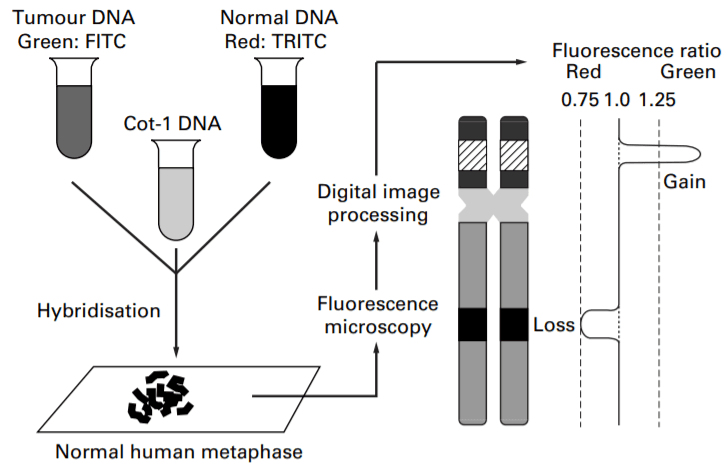
Figure 2: The figure shows the difference between the comparative genomic hybridization (CGH) and array-CGH. Notice how both determine the ratio of fluorophores and predict the gain or loss of a specific chromosomal locus.
Advantages
Limitations
The primedin situ hybridization technique was first used to visualize the difference between the ɑ-satellite region of the two different chromosomes of humans. This technique is more sensitive and faster compared to all the other available FISH techniques[4]. A major difference between both techniques is; that FISH involves the use of labeled probes while PRINS involves the use of unlabeled probes.
Method
This technique involves the use of unlabeled probes. When the unlabeled probes are mixed with the test sample, labeled dNTPs, and DNA polymerase, probes bind with the specific complementary target sequence. After binding with the target sequence, they act as a primer, and a chain elongation reaction is catalyzed by the DNA polymerase (it uses labeled dNTPs) at hybridizing site. The reaction is catalyzed in three primary steps: (1) denaturation, (2) annealing, and (3) elongation. So, only the probe binding at the target site will be labeled.
The use of unlabeled probes in the PRINS technique helps in reducing the background disturbances/signals very efficiently. As only the probe binding to its target sequence will be polymerized and incorporate labeled dNTPs (which will give color to that particular chromosomal region)[4]. Moreover, this technique requires only 5-30 minutes for the reaction to occur. Because of the lesser time of the reaction, the morphology of the chromosome is well preserved.
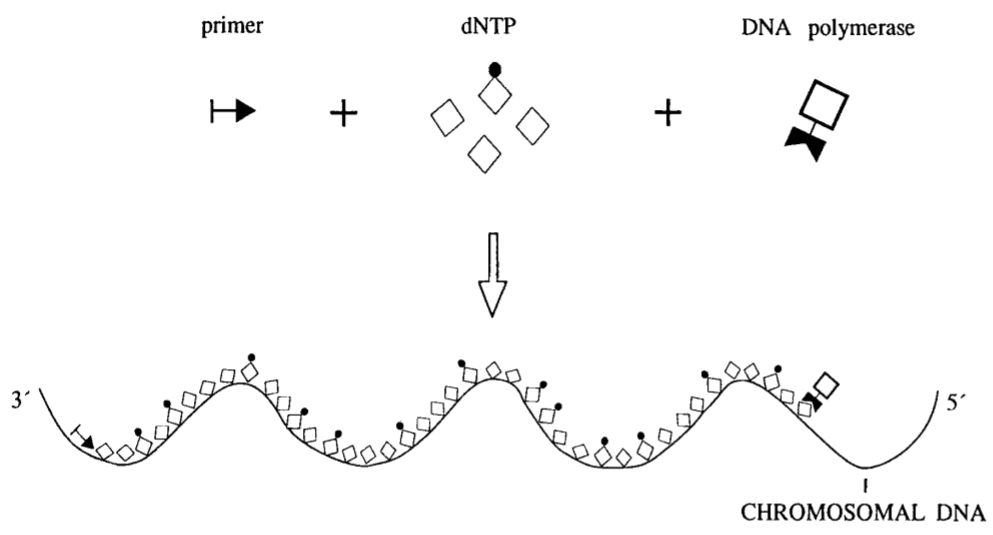
Figure 3: The image shows the PRINS reaction. The probe which binds at the target sequence act as primer and polymerase chain reaction only occurs at that place.
Advantages
Limitations
Spectral karyotyping (SKY) and M-FISH techniques are very advanced FISH-modified techniques. SKY technique was first introduced by Schröck E et al. in 1996. Both techniques involve the use of multicolor probes; 3-7 differently colored probes are used for single hybridization[6]. The only difference in both techniques is: SKY colors one entire chromosome in only one color whereas M-FISH highlights the regions of a chromosome in a different colored banding pattern. All 24 color combinations (generated from 3-5 differently colored probes) can be observed in the M-FISH technique. Presently, ‘SKY’ is being used to analyze the human, rat, and mouse chromosomes.
The procedures of both techniques are the same except for the software used to analyze the obtained images. That is why, in this section, only one technique – the SKY technique – will be discussed.
Method
Basic steps[10] involved in the SKY technique are given below:
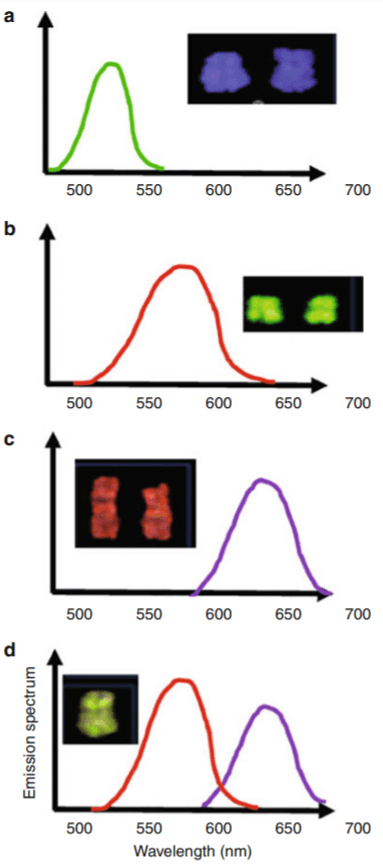
Figure 4: The image on the left-hand side shows how the software analyzes the spectral characteristic to identify chromosomes.
The image on the right-hand side shows DAP I (black and white[A]) stained and fluorochrome stained images [B]. [C] shows the karyotype of chromosomes stained in both (DAPI and fluorochrome) ways.
Advantages
Limitations
Spectral Karyotyping (SKY) Technique
Molecular cytogenetics involve techniques based on the concept of in situ hybridization, such as Fluorescent in situ hybridization (FISH), spectral karyotyping (SKY), primed in situ hybridizations (PRINS), and comparative genomic hybridization (CGH). All these techniques involve the use of labeled probes, except PRINS in which labeled dNTPs (and unlabeled probes) are used instead of labeled probes. These techniques have made research easier and faster by providing reliable results in 1-3 hours and by allowing the analysis of multiple samples simultaneously. All these techniques have vast applications in clinical cytogenetics to diagnose various chromosomal aberrations (macro, as well as micro aberrations). Diagnosis and treatment (which help to develop targeted therapies) of cancer have also become easy since the evolution of these techniques. Molecular cytogenetics colored the world of chromosomes and it is expected that all the limitations will be overcome through the use of combinatorial approaches to these techniques.
In behavioral neuroscience, the Open Field Test (OFT) remains one of the most widely used assays to evaluate rodent models of affect, cognition, and motivation. It provides a non-invasive framework for examining how animals respond to novelty, stress, and pharmacological or environmental manipulations. Among the test’s core metrics, the percentage of time spent in the center zone offers a uniquely normalized and sensitive measure of an animal’s emotional reactivity and willingness to engage with a potentially risky environment.
This metric is calculated as the proportion of time spent in the central area of the arena—typically the inner 25%—relative to the entire session duration. By normalizing this value, researchers gain a behaviorally informative variable that is resilient to fluctuations in session length or overall movement levels. This makes it especially valuable in comparative analyses, longitudinal monitoring, and cross-model validation.
Unlike raw center duration, which can be affected by trial design inconsistencies, the percentage-based measure enables clearer comparisons across animals, treatments, and conditions. It plays a key role in identifying trait anxiety, avoidance behavior, risk-taking tendencies, and environmental adaptation, making it indispensable in both basic and translational research contexts.
Whereas simple center duration provides absolute time, the percentage-based metric introduces greater interpretability and reproducibility, especially when comparing different animal models, treatment conditions, or experimental setups. It is particularly effective for quantifying avoidance behaviors, risk assessment strategies, and trait anxiety profiles in both acute and longitudinal designs.
This metric reflects the relative amount of time an animal chooses to spend in the open, exposed portion of the arena—typically defined as the inner 25% of a square or circular enclosure. Because rodents innately prefer the periphery (thigmotaxis), time in the center is inversely associated with anxiety-like behavior. As such, this percentage is considered a sensitive, normalized index of:
Critically, because this metric is normalized by session duration, it accommodates variability in activity levels or testing conditions. This makes it especially suitable for comparing across individuals, treatment groups, or timepoints in longitudinal studies.
A high percentage of center time indicates reduced anxiety, increased novelty-seeking, or pharmacological modulation (e.g., anxiolysis). Conversely, a low percentage suggests emotional inhibition, behavioral avoidance, or contextual hypervigilance. reduced anxiety, increased novelty-seeking, or pharmacological modulation (e.g., anxiolysis). Conversely, a low percentage suggests emotional inhibition, behavioral avoidance, or contextual hypervigilance.
The percentage of center time is one of the most direct, unconditioned readouts of anxiety-like behavior in rodents. It is frequently reduced in models of PTSD, chronic stress, or early-life adversity, where animals exhibit persistent avoidance of the center due to heightened emotional reactivity. This metric can also distinguish between acute anxiety responses and enduring trait anxiety, especially in longitudinal or developmental studies. Its normalized nature makes it ideal for comparing across cohorts with variable locomotor profiles, helping researchers detect true affective changes rather than activity-based confounds.
Rodents that spend more time in the center zone typically exhibit broader and more flexible exploration strategies. This behavior reflects not only reduced anxiety but also cognitive engagement and environmental curiosity. High center percentage is associated with robust spatial learning, attentional scanning, and memory encoding functions, supported by coordinated activation in the prefrontal cortex, hippocampus, and basal forebrain. In contrast, reduced center engagement may signal spatial rigidity, attentional narrowing, or cognitive withdrawal, particularly in models of neurodegeneration or aging.
The open field test remains one of the most widely accepted platforms for testing anxiolytic and psychotropic drugs. The percentage of center time reliably increases following administration of anxiolytic agents such as benzodiazepines, SSRIs, and GABA-A receptor agonists. This metric serves as a sensitive and reproducible endpoint in preclinical dose-finding studies, mechanistic pharmacology, and compound screening pipelines. It also aids in differentiating true anxiolytic effects from sedation or motor suppression by integrating with other behavioral parameters like distance traveled and entry count (Prut & Belzung, 2003).
Sex-based differences in emotional regulation often manifest in open field behavior, with female rodents generally exhibiting higher variability in center zone metrics due to hormonal cycling. For example, estrogen has been shown to facilitate exploratory behavior and increase center occupancy, while progesterone and stress-induced corticosterone often reduce it. Studies involving gonadectomy, hormone replacement, or sex-specific genetic knockouts use this metric to quantify the impact of endocrine factors on anxiety and exploratory behavior. As such, it remains a vital tool for dissecting sex-dependent neurobehavioral dynamics.
The percentage of center time is one of the most direct, unconditioned readouts of anxiety-like behavior in rodents. It is frequently reduced in models of PTSD, chronic stress, or early-life adversity. Because it is normalized, this metric is especially helpful for distinguishing between genuine avoidance and low general activity.
Environmental Control: Uniformity in environmental conditions is essential. Lighting should be evenly diffused to avoid shadow bias, and noise should be minimized to prevent stress-induced variability. The arena must be cleaned between trials using odor-neutral solutions to eliminate scent trails or pheromone cues that may affect zone preference. Any variation in these conditions can introduce systematic bias in center zone behavior. Use consistent definitions of the center zone (commonly 25% of total area) to allow valid comparisons. Software-based segmentation enhances spatial precision.
Evaluating how center time evolves across the duration of a session—divided into early, middle, and late thirds—provides insight into behavioral transitions and adaptive responses. Animals may begin by avoiding the center, only to gradually increase center time as they habituate to the environment. Conversely, persistently low center time across the session can signal prolonged anxiety, fear generalization, or a trait-like avoidance phenotype.
To validate the significance of center time percentage, it should be examined alongside results from other anxiety-related tests such as the Elevated Plus Maze, Light-Dark Box, or Novelty Suppressed Feeding. Concordance across paradigms supports the reliability of center time as a trait marker, while discordance may indicate task-specific reactivity or behavioral dissociation.
When paired with high-resolution scoring of behavioral events such as rearing, grooming, defecation, or immobility, center time offers a richer view of the animal’s internal state. For example, an animal that spends substantial time in the center while grooming may be coping with mild stress, while another that remains immobile in the periphery may be experiencing more severe anxiety. Microstructure analysis aids in decoding the complexity behind spatial behavior.
Animals naturally vary in their exploratory style. By analyzing percentage of center time across subjects, researchers can identify behavioral subgroups—such as consistently bold individuals who frequently explore the center versus cautious animals that remain along the periphery. These classifications can be used to examine predictors of drug response, resilience to stress, or vulnerability to neuropsychiatric disorders.
In studies with large cohorts or multiple behavioral variables, machine learning techniques such as hierarchical clustering or principal component analysis can incorporate center time percentage to discover novel phenotypic groupings. These data-driven approaches help uncover latent dimensions of behavior that may not be visible through univariate analyses alone.
Total locomotion helps contextualize center time. Low percentage values in animals with minimal movement may reflect sedation or fatigue, while similar values in high-mobility subjects suggest deliberate avoidance. This metric helps distinguish emotional versus motor causes of low center engagement.
This measure indicates how often the animal initiates exploration of the center zone. When combined with percentage of time, it differentiates between frequent but brief visits (indicative of anxiety or impulsivity) versus fewer but sustained center engagements (suggesting comfort and behavioral confidence).
The delay before the first center entry reflects initial threat appraisal. Longer latencies may be associated with heightened fear or low motivation, while shorter latencies are typically linked to exploratory drive or low anxiety.
Time spent hugging the walls offers a spatial counterbalance to center metrics. High thigmotaxis and low center time jointly support an interpretation of strong avoidance behavior. This inverse relationship helps triangulate affective and motivational states.
By expressing center zone activity as a proportion of total trial time, researchers gain a metric that is resistant to session variability and more readily comparable across time, treatment, and model conditions. This normalized measure enhances reproducibility and statistical power, particularly in multi-cohort or cross-laboratory designs.
For experimental designs aimed at assessing anxiety, exploratory strategy, or affective state, the percentage of time spent in the center offers one of the most robust and interpretable measures available in the Open Field Test.
Written by researchers, for researchers — powered by Conduct Science.








Monday – Friday
9 AM – 5 PM EST
DISCLAIMER: ConductScience and affiliate products are NOT designed for human consumption, testing, or clinical utilization. They are designed for pre-clinical utilization only. Customers purchasing apparatus for the purposes of scientific research or veterinary care affirm adherence to applicable regulatory bodies for the country in which their research or care is conducted.